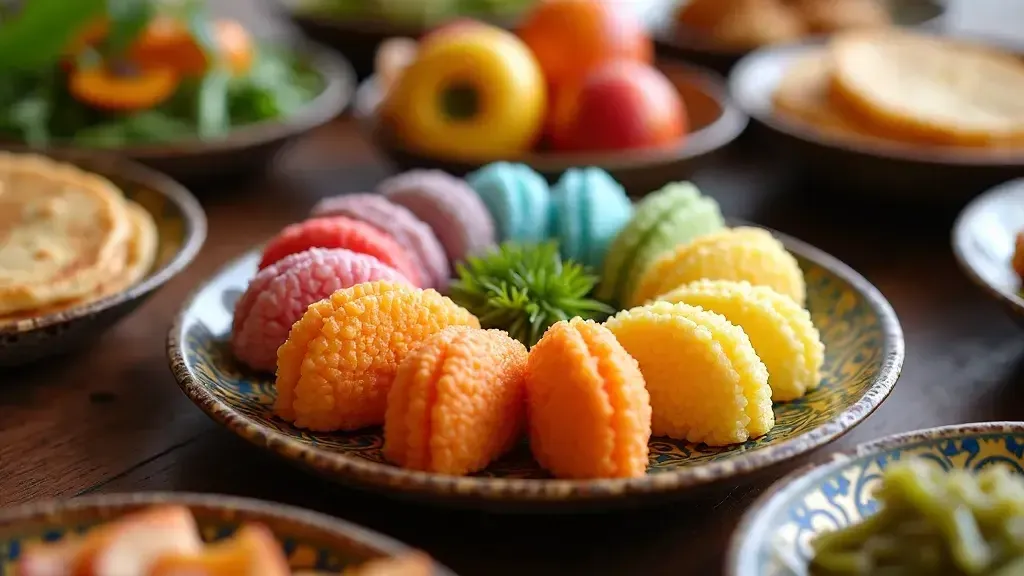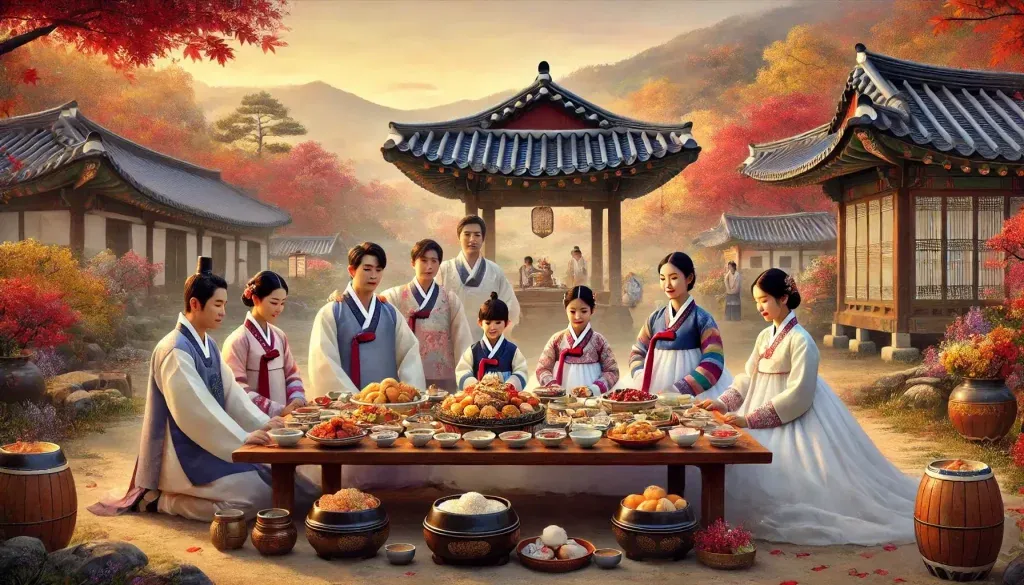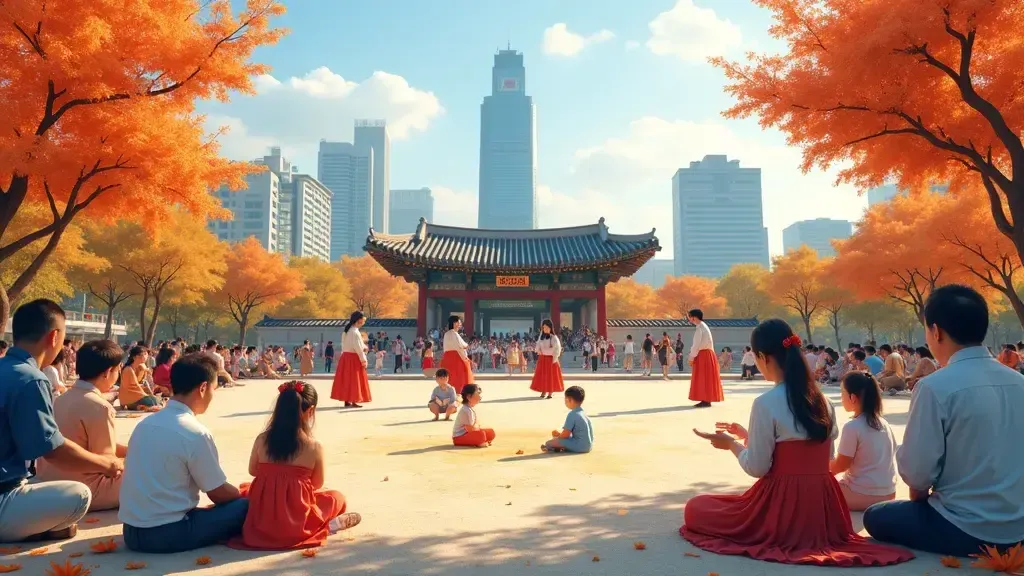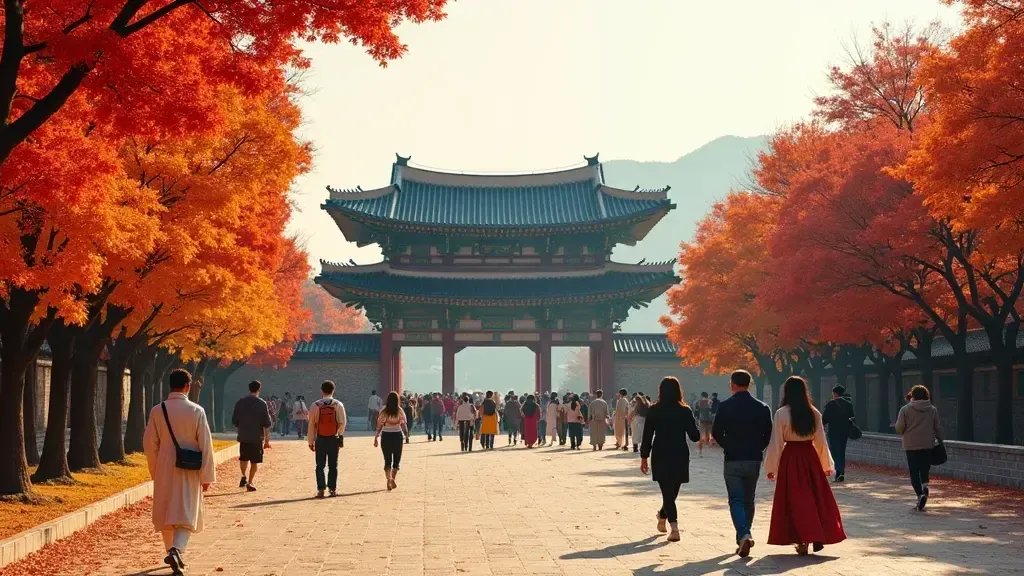Chuseok, the Mid-Autumn Festival, is one of South Korea’s most important cultural celebrations. It’s a time for families to gather, give thanks for the harvest, and honor their ancestors. Similar to the Mooncake Festival in other parts of Asia, Chuseok is deeply rooted in traditions passed down through generations in South Korea.
What makes this holiday so special? Let’s explore Chuseok, its customs, and how you can experience it firsthand in South Korea.

In this article:
- What is Chuseok?
- Traditional Chuseok Foods: The Symbolism Behind Songpyeon and Festive Dishes
- Family Reunions and Ancestral Rituals
- Chuseok vs. Other Mid-Autumn Festivals
- How South Korea Celebrates Chuseok Today
- How To Plan Your Visit to South Korea During Chuseok
What is Chuseok?
Chuseok, or Hangawi, is a three-day holiday in South Korea. It celebrates the autumn full moon on the 15th day of the lunar calendar’s eighth month. The holiday marks the Korean version of a mooncake festival and is often termed the “Korean Thanksgiving.” The term “Chuseok” itself destroys its meaning by meaning “Autumn evening,” showing the time of year at which the harvest comes.
Chuseok comes from Korea’s farming roots, thousands of years ago. Communities would celebrate a time of large harvests. Farmers would then thank the spirits of their ancestors. They believed the spirits had given them such a large amount. Right here, lies the core of Chuseok: to be thankful to nature and family. It is still a favorite holiday, it is a time to stop the rush of life and remember old traditions by greeting loved ones.
Millions of South Koreans head to their hometowns to spend time with their family. Some important themes of the festival include ancestral traditions, large amounts of family meals, and visiting of the graves. For them, it’s not just about thanking for the harvest. It’s about the “harvest” of family, relationships, and shared memories.
Traditional Chuseok Foods
Of all the highlights that occur during Chuseok, food stands out, especially some food prepared only for the event. It’s similar to the mooncake festival in Korea and other Asian countries. Food is the main focus of the celebration.
During Chuseok, people considered Songpyeon to be the main food to eat. Makers use finely ground rice flour to create these half-moon-shaped rice cakes. Sweetened sesame seeds, red bean paste, or sometimes chestnuts fill them. Songpyeon is traditionally made with family. People say that whoever shapes the most beautiful songpyeon will have the most beautiful daughter. Songpyeon is not only a dessert but also brings the meaning of a good and successful year.

Other popular Chuseok dishes include jeon. They are Korean pancakes made with fish, vegetables, or meat. Galbi is also a type of marinated short rib. We share fresh fruits and newly harvested grains. They represent the good harvest that Chuseok is celebrating. Just as people give out mooncakes during the mooncake festival in Korea and China, cooks prepare these dishes with care and tradition. The meal is an important tradition in itself.
Family Reunions and Ancestral Rituals
Family and tradition are the core of Chuseok. Like other autumn harvest festivals, Chuseok is a time for family. They gather to eat, tell stories, and share memories. One of the primary traditions that is practiced in this holiday is charye or ancestral rituals.
Charye involves setting the table with food offerings like sacred rice, fruits, and vegetables. These are then given in a special tradition to ancestors. We put food on the table very carefully because the location of each item has meaningful importance. These are offerings to spirits for having led the family through this path and making sure of a good yield from the crops.

Another major part of the holiday is seongmyo. Families visit ancestral graves to clean the tombs and pay respects. Remembering the past creates a strong connection. So, this shared experience of seongmyo reminds us that family is important in Korean culture. For many, this is a rare chance to spend time with far-away relatives. So, the family aspect of Chuseok is as important as the holiday.
Chuseok vs. Other Mid-Autumn Festivals
Chuseok is often called Korea’s answer to the mooncake festival and the other mid-autumn festivals in East Asia. These festivals share some similarities. But, they also reflect their own cultures.
While mooncakes are the key symbols of the Mid-Autumn Festival in China, for example, in Korea, it is songpyeon. Both festivals celebrate the harvest. They focus on family and giving thanks. But, their traditions differ slightly. In China, lanterns are often lit to represent unity. In contrast, Korean traditions focus on ancestral rites. They prepare certain foods to give to the spirits.
In Japan, people call the Mid-Autumn Festival Tsukimi, or “moon viewing.” They gather to enjoy the full moon and eat seasonal foods like dango. Japanese celebrations focus on appreciating the moon’s beauty. Chuseok, though, is about honoring the harvest and family.
Despite the many differences, a note of thanks echoes through all these festivals. It makes for a deeply spiritual time in their cultures. Korea’s mooncake festival and Chuseok are different. They show unique Asian ways to give thanks for the harvest and reflect on family ties.
How South Korea Celebrates Chuseok Today
As with many traditional festivals, Chuseok has moved along with modern times. The core customs-family reunion, ancestor traditions, and special foods-have not changed. But, modern Chuseok blends old and new. In big cities like Seoul, people are at Chuseok events. They include traditional games, cultural performances, and modern festivals in parks and cultural centers.
These days, Koreans still gather to eat. But, they now go to restaurants with special Chuseok menus or improved versions of the above-mentioned food. Another holiday activity is gift shopping. Many Koreans exchange specially chosen gift sets, often food, cosmetics, or health products.

The internet and all that came with it also made some parts of Chuseok go digital. This generation shared the festival online. Despite modern influences, Chuseok’s spirit is its customs. They are to gather as a family, share food, and honor their ancestors.
How To Plan Your Visit to South Korea During Chuseok
If you happen to visit South Korea during Chuseok, then you are in for really something cultural. However, Chuseok is one of the busiest holidays. It requires a little more planning. Many Koreans go back to their hometowns. It usually gets sold out long before the festival. Make sure your ticket and stay are well booked in advance to avoid last-minute problems.
During Chuseok, major cities such as Seoul may be quieter, with most of its residents traveling out of town. But, this is the best time to visit cultural heritage sites. Many museums, palaces, and temples have special events and performances. You get to enjoy traditional folk games and traditional dance performances, and you can even make songpyeon.
Also, remember that many business restaurants and shops may close on Chuseok. Larger department stores and most tourist places to visit usually stay open. Many even have Chuseok-themed products and events. But, they can’t keep all places open.

Stay Connected in South Korea with Yoho Mobile
Stay connected while exploring South Korea with Yoho Mobile’s top mobile plans. They offer affordable and flexible options to keep you in touch with friends and family, whether you’re navigating Seoul’s busy streets or venturing into rural areas. With Yoho Mobile, you’ll have everything you need to enjoy the next Chuseok holiday!
🎁 Special Discount for Our Readers!
As a special treat for our readers, Yoho Mobile is offering an exclusive discount! Use our coupon code “YOHOREADERSAVE” to get your first order for FREE!
Don’t miss out on this opportunity to stay connected affordably while exploring South Korea.
